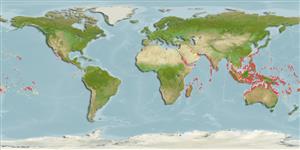Environment: milieu / climate zone / depth range / distribution range
Ecologie
marien rifbewoner; diepte 2 - 25 m (Ref. 90102). Tropical; 30°N - 30°S
Indo-Pacific.
Grootte / Gewicht / Leeftijd
Maturity: Lm ? range ? - ? cm
Max length : 29.0 cm TL mannelijk / geslacht onbekend; (Ref. 30573); common length : 18.0 cm TL mannelijk / geslacht onbekend; (Ref. 30573)
Dorsale stekels (totaal) : 5; Dorsale zachte stralen (totaal) : 21 - 22; Anale stekels: 1; Anale zachte stralen: 17 - 18. Easily identified by the large black blotch on the tail. Body and head spotted, except in large males that feature lines on the cheek instead (Ref. 48636). Upper third of body greenish to brownish grey, flecked with dark brown, the lower two-thirds white with 3 or 4 longitudinal rows of small dark brown spots, sometimes linked by narrow dark stripes except lower row as discrete yellow-edged black spots. Caudal fin with a very large black spot centrobasally in fin. Last membrane of spinous portion of dorsal fin connected to first dorsal-fin ray nearly at height of fifth dorsal-fin spine (Ref 42740).
Found on sand and rubble bottoms of shallow lagoon and protected seaward reefs (Ref. 9710, 48636). Also Ref. 58652.
Levenscyclus en paargedrag
Maturiteit | Voortplanting | Paaien | Eieren | Fecunditeit | Larven
Randall, J.E., G.R. Allen and R.C. Steene, 1990. Fishes of the Great Barrier Reef and Coral Sea. University of Hawaii Press, Honolulu, Hawaii. 506 p. (Ref. 2334)
Status op de Rode Lijst van het IUCN (Ref. 130435: Version 2024-2)
Gevaar voor de mens
Harmless
Gebruik door de mens
Visserij: van minder commercieel belang; Aquarium: Commercieel
Tools
Speciale rapporten
Download XML
Internetbronnen
Estimates based on models
Preferred temperature (Ref.
123201): 24.9 - 29.3, mean 28.3 °C (based on 3415 cells).
Fylogenetische diversiteitsindex (Ref.
82804): PD
50 = 0.5000 [Uniqueness, from 0.5 = low to 2.0 = high].
Bayesian length-weight: a=0.00813 (0.00502 - 0.01317), b=3.11 (2.97 - 3.25), in cm total length, based on LWR estimates for this species & Genus-body shape (Ref.
93245).
Trofisch niveau (Ref.
69278): 3.6 ±0.3 se; based on diet studies.
Generation time: 2.4 ( na - na) years. Estimated as median ln(3)/K based on 1
growth studies.
Weerstandsvermogen (Ref.
120179): Hoog, minimale populatieverdubbelingstijd minder dan 15 maanden (K=0.4).
Fishing Vulnerability (Ref.
59153): Low to moderate vulnerability (28 of 100).
Nutrients (Ref.
124155): Calcium = 70.3 [38.9, 107.2] mg/100g; Iron = 0.585 [0.371, 0.959] mg/100g; Protein = 18.2 [16.0, 20.2] %; Omega3 = 0.0888 [, ] g/100g; Selenium = 29.6 [16.4, 54.9] μg/100g; VitaminA = 85.4 [31.5, 225.3] μg/100g; Zinc = 1.32 [0.93, 1.82] mg/100g (wet weight);
